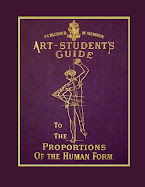
Julien Fau, doctor of medicine in Paris, edited two different anatomic works for artists: Anatomie des formes exterieures du corps humain, a l'usage des peintres et des sculpteurs, and Anatomie
artistique elementaire.
The first was published in 1845 and the second in 1850. Art students of the time were likely to own and study closely one or the other. The first, which translates the The Anatomy of the External Form of Man for Painters and Sculptors
Here is a description of the books from Ludwig Choulant's History and Bibliography of Anatomic Illustration in its Relation to Anatomic Science and the Graphic Arts
JULIEN FAU
Julien Fau, doctor of medicine in Paris, edited two different anatomic works for artists:
Anatomie des formes exterieures du corps humain, a I'usage des peintres et des sculpteurs. Avec un Atlas de 24 planches dessinees d'apres nature et lithographiies par M. Leveille, eleve de M. Jacob. Paris: M6quignonMarvis fils, 1845 (I0 and 214 pp.), 8° and fol. (24 lithographic plates), black and white and also colored.
The plates are very beautifully finished and comprise one plate of skulls of different nationalities; several different views of the nude bodies of a man, a woman, and a child, all drawn from nature, some of them supplemented by skeletons placed alongside of the bodies, with the body outlines; representations of the bones, and the muscles, the latter with the bones in some cases drawn in. Particular attention has been given to the various positions and flexions of the extremities. The last plate represents the myology of the Laocoon, without the sons, after Charles Clement Bervic's well-known print. This work has been translated into English, with additions, by the physician Robert Knox, and published under the title: The anatomy of the external forms of man, intended for the use of artists, painters and sculptors, London, 1848, 8°, with an atlas of 26 plates in quarto; published in black and white and also colored. The second, smaller, and less expensive work by Fau is:Anatomie arlistique elementaire. Dessins d'apres nature par J. B. Leveille, gravures sur acier. Paris: Mequignon-Marvis, 1850, 8°, with 17 steel engravings in 8°, three of which are in small folio.
In this work the representation of the shapes of skulls, of the nude bodies, and of the Laocoon are missing, but representations of three beautiful skeletons, with the contours drawn around them, have been added. The remainder deals with osteology and myology, although less exhaustively than in the previous work.
J.B. Leveille was a noted anatomical engraver among his books were: Neurologie ou description du systeme nerveux
A course of operative surgery
Névrologie et esthésiologie. Traité et iconographie du système at Abebooks.com,
Hippocrate interprété par lui-même,
Traité pratique des maladies des yeux et expériences,
Traité et iconographie du système nerveux.
History and Bibliography of Anatomic Illustration in Its Relation to Anatomic Science and the Graphic Arts
A Course of Operative Surgery
Related Posts:
The Anatomy of the External Forms of Man by Julien Fau
Anatomy for Art Students, Painters, and Sculptors - The Art Student's Guide to External Anatomy

The text without the plates at Google Books.
Another copy of the English translation by Robert Knox without the plates at Google Books.
Here is a quote from the Monuments of Medicine Collection at the Washington University School of Medicine, Bernard Becker Collection:
Although little is known about Julien Fau’s life, his published works highlight his various talents. As a medical doctor, he created three different artistic anatomies, which appeared in more than ten French, English and Dutch editions. This atlas of his was intended specifically for the use of painters and sculptors. His models often follow classic examples. This male figure showing the muscles of the human body is a copy of the ancient Greek statue of Laocoon. Fau’s interests also included surprisingly modern areas, such as photography: he wrote on the collodion process as early as 1854.
Related book with reproductions of old prints including black and white images from The Anatomy of the External Form of Man:





























No comments:
Post a Comment